import numpy as np
from qiskit_aer import AerSimulator
from qiskit.quantum_info import Statevector, Operator
from qiskit.visualization import plot_histogram
from qiskit import QuantumCircuit, QuantumRegister, ClassicalRegister
sim = AerSimulator()
from util import zero, one
QI: Superdense Coding#
In this notebook, we’ll introduce superdense coding. It is a protocol that enables two parties to share two classical bits of information using a shared and entangled qubit.
References
Introduction to Quantum Information Science: Lecture 9 by Scott Aaronson
Quantum Computation and Quantum Information: Chapter 2, Nielsen and Chuang
Protocol#
The superdense coding protocol involves
an entangled qubit that Alice and Bob will share,
a message encoding step that Alice will apply to a send a message, and
a message decoding step that Bob will apply to decode the sent message.
Part 1: Create Bell State#
We need a third party, Charlie, to create an entangled bell state.
Charlie will send qubit \(|q_1\rangle\) to Alice.
Charlie will send qubit \(|q_0\rangle\) to Bob.
def create_alice_bob() -> QuantumCircuit:
alice_qubit = QuantumRegister(1, "q_Alice")
bob_qubit = QuantumRegister(1, "q_Bob")
return QuantumCircuit(bob_qubit, alice_qubit)
def create_bell_state(qc: QuantumCircuit) -> QuantumCircuit:
qc.h(1)
qc.cx(1, 0)
return qc
create_bell_state(create_alice_bob()).draw(output="mpl", style="iqp")
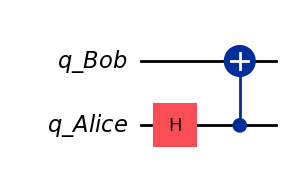
Part 2: Encode Message#
Alice will use the following encoding scheme to encode classical bits into quantum state.
00: \(\frac{1}{\sqrt{2}}|00\rangle + \frac{1}{\sqrt{2}}|11\rangle\)
10: \(\frac{1}{\sqrt{2}}|00\rangle - \frac{1}{\sqrt{2}}|11\rangle\)
01: \(\frac{1}{\sqrt{2}}|01\rangle + \frac{1}{\sqrt{2}}|10\rangle\)
11: \(\frac{1}{\sqrt{2}}|01\rangle - \frac{1}{\sqrt{2}}|10\rangle\)
To implement this coding scheme, Alice can use a message-specific quantum circuit. Thus she will end up with four circuits.
def encode_message(qc, msg: str) -> QuantumCircuit:
# Adapted from: https://learn.qiskit.org/course/ch-algorithms/superdense-coding
# Create quantum circuit that sends `msg`
if len(msg) != 2 or not set(msg).issubset({"0", "1"}):
raise ValueError(f"message '{msg}' is invalid")
# Encode message
if msg[1] == "1":
qc.x(1)
if msg[0] == "1":
qc.z(1)
if msg[0] == "0" and msg[1] == "0":
qc.id(1)
return qc
Messsage 00#
The message for 00 is given by
message = "00"
qc_00 = create_bell_state(create_alice_bob())
qc_00.barrier(label="Charlie hand off point")
qc_00 = encode_message(qc_00, message)
qc_00.draw(output="mpl", style="iqp")

m_00 = (zero ^ zero).evolve(qc_00)
m_00.draw("latex")
Messsage 10#
The message for 10 is given by
message = "10"
qc_10 = create_bell_state(create_alice_bob())
qc_10.barrier(label="Charlie hand off point")
qc_10 = encode_message(qc_10, message)
qc_10.draw(output="mpl", style="iqp")

m_10 = (zero ^ zero).evolve(qc_10)
m_10.draw("latex")
Messsage 01#
The message for 01 is given by
message = "01"
qc_01 = create_bell_state(create_alice_bob())
qc_01.barrier(label="Charlie hand off point")
qc_01 = encode_message(qc_01, message)
qc_01.draw(output="mpl", style="iqp")

m_01 = (zero ^ zero).evolve(qc_01)
m_01.draw("latex")
Messsage 11#
The message for 11 is given by
message = "11"
qc_11 = create_bell_state(create_alice_bob())
qc_11.barrier(label="Charlie hand off point")
qc_11 = encode_message(qc_11, message)
qc_11.draw(output="mpl", style="iqp")

m_11 = (zero ^ zero).evolve(qc_11)
m_11.draw("latex")
Observation 1: All messages are orthogonal#
The messages are all orthogonal to each other.
# Orthogonality check
messages = [m_00, m_10, m_01, m_11]
for i, m1 in enumerate(messages):
for j, m2 in enumerate(messages):
if i != j and not np.allclose(np.dot(m_00, m_01), [0]):
print("Not orthogonal", m1, m2)
Observation 2: Ambiguity#
Although the encoding of the message for 01 and 11 are orthogonal, we still cannot distinguish them by measurement unless we choose an appropriate basis. We demonstrate the ambiguity in distinguishing 01 and 11 now.
def test_encode_message(msg):
qc = QuantumCircuit(2, 2)
qc = create_bell_state(qc)
qc = encode_message(qc, msg)
qc.measure(0, 0); qc.measure(1, 1)
result = sim.run(qc).result()
counts = result.get_counts(qc)
return counts, qc
counts, qc = test_encode_message("01")
plot_histogram(counts)
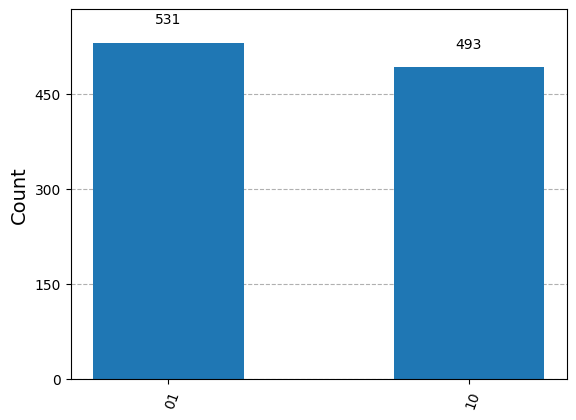
# Gives same histogram as 10
counts, qc = test_encode_message("11")
plot_histogram(counts)
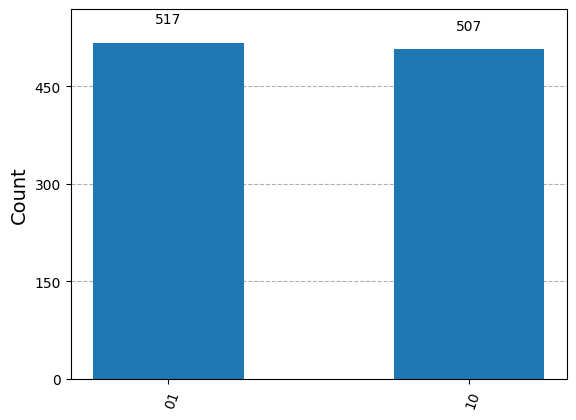
Part 3: Decode Message#
After Alice encodes the message, Charlie will transport the qubit from Alice to Bob. Thus Bob will have both qubits now. However, Bob cannot directly measure the qubits to the get the results due to the ambiguity in distinguishing 01 from 11. Instead, Bob will need to perform decoding in an appropriate basis. This is accomplished with the circuit below.
def decode_message(qc: QuantumCircuit) -> QuantumCircuit:
qc.cx(1, 0)
qc.h(1)
return qc
qc_10 = create_alice_bob()
qc_10.initialize(m_10)
qc_10 = decode_message(qc_10)
qc_10.draw(output="mpl", style="iqp")
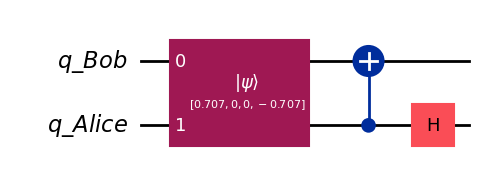
(zero ^ zero).evolve(qc_10).draw('latex')
qc_11 = create_alice_bob()
qc_11.initialize(m_11)
qc_11 = decode_message(qc_11)
qc_11.draw(output="mpl", style="iqp")
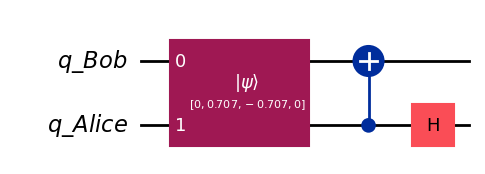
(zero ^ zero).evolve(qc_11).draw('latex')
Why does this work?#
If Bob obtains \(\frac{1}{\sqrt{2}}|00\rangle + \frac{1}{\sqrt{2}}|11\rangle\) (for
00), then
If Bob obtains \(\frac{1}{\sqrt{2}}|00\rangle - \frac{1}{\sqrt{2}}|11\rangle\) (for
10), then
If Bob obtains \(\frac{1}{\sqrt{2}}|01\rangle + \frac{1}{\sqrt{2}}|10\rangle\) (for
01), then
If Bob obtains \(\frac{1}{\sqrt{2}}|01\rangle - \frac{1}{\sqrt{2}}|10\rangle\) (for
11), then
Putting it Together#
We put the entire protocol together for end-to-end experimentation.
def superdense_coding(msg: str):
alice_qubit = QuantumRegister(1, "q_Alice")
bob_qubit = QuantumRegister(1, "q_Bob")
result = ClassicalRegister(2, "decode")
qc = QuantumCircuit(bob_qubit, alice_qubit, result)
# Part 1: Third party creates entangled state
qc = create_bell_state(qc)
qc.barrier(label="Charlie hand off point")
# Part 2: Alice encode message on qubit 1
qc = encode_message(qc, msg)
qc.barrier(label="Charlie sends \nAlice's qubit to Bob")
# Part 3: Bob puts in basis and measures
qc = decode_message(qc)
qc.measure(0, 0); qc.measure(1, 1)
result = sim.run(qc).result()
counts = result.get_counts(qc)
return counts, qc
counts, qc = superdense_coding("00")
qc.draw(output="mpl", style="iqp")

plot_histogram(counts)
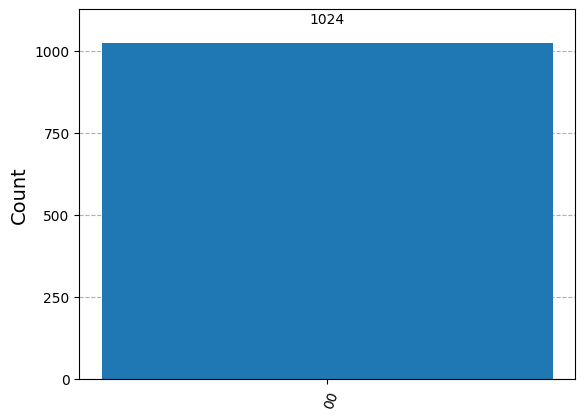
# Change message
message = "01"
counts, qc = superdense_coding(message)
plot_histogram(counts)
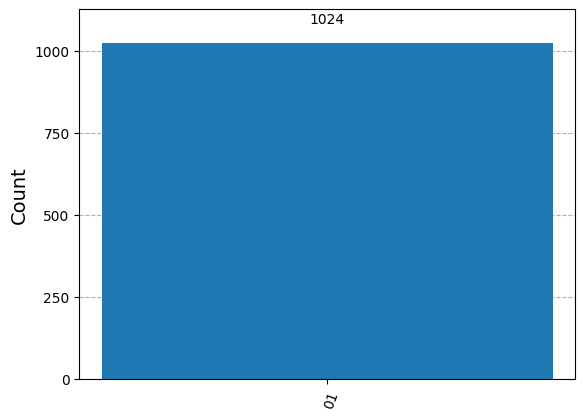
Summary#
First example of quantum protocol.
We were able to transmit 2 classical bits using 1 entangled qubit.
Thus we have a quantum system that is split across two parties.
